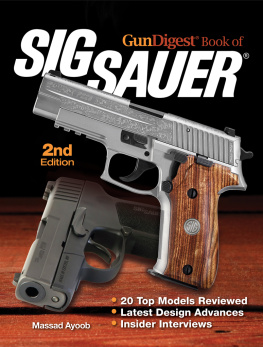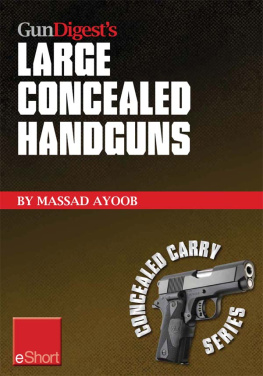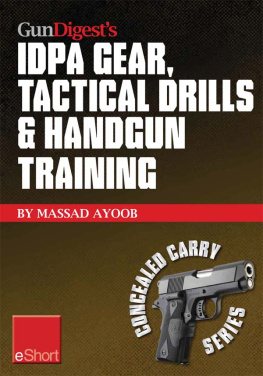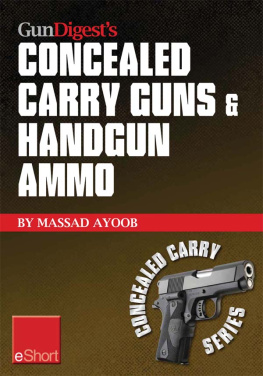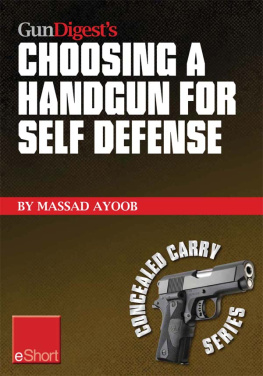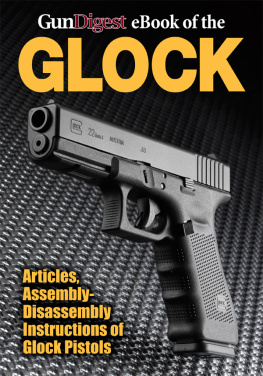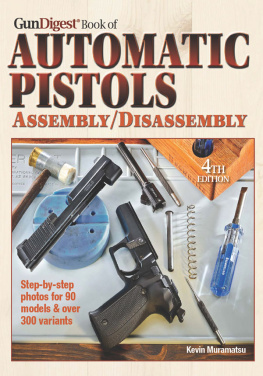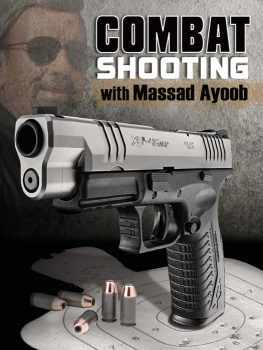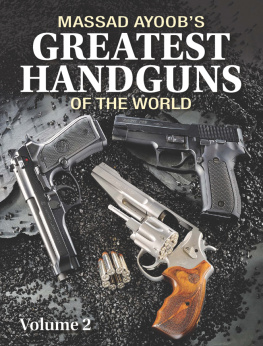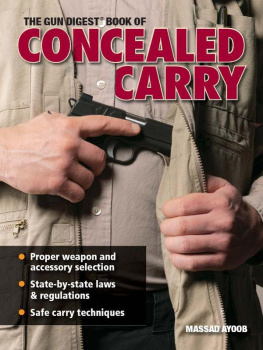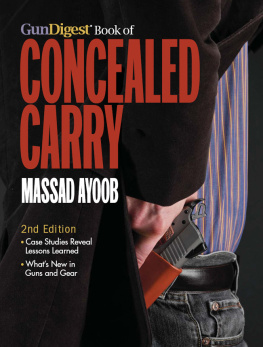Contents
Guide
Gun Digest Book of
SIG SAUER
2nd
Edition
Massad Ayoob
Contents
Introduction
It was an honor to be asked to write the Gun Digest Book of SIG-Sauer. These are handguns with which Ive had a long and most agreeable acquaintance. My work, as a firearms and deadly force instructor and as a writer/tester for gun magazines, has brought me into contact with more of them than I can count. It brings me into contact with lots of other fine guns, too, and thats been useful in putting the SIG pistols in context.
When it was announced at an executive meeting at SIG that Id be writing this book, one fellow blurted, They cant let him write it! Hes a Glock guy!
After I stopped laughing, I realized he was partly right. I am a Glock guy. Im also a Colt and Smith and Ruger guy, and a Beretta, Browning, and HK guy and yes, a SIG guy too. Damn it, Im a gun guy.
And thats the angle from which this book comes. I was hired by Krause Publications, not SIG. Im not here to sell the guns. Im here to tell you what weve learned about them. Ive shot SIGs in matches, carried them on and off duty, taught classes with them, and kept them for home defense. But far more has been learned from the collective experience of law enforcement and military, and a vast nation of law-abiding armed citizens.
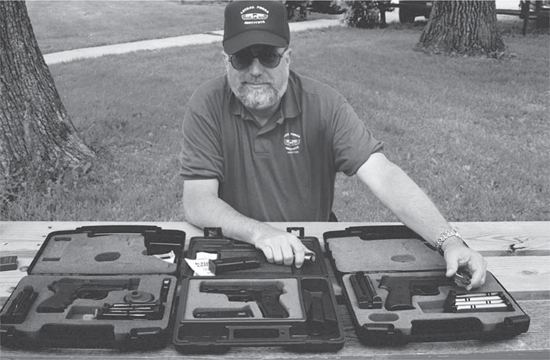
Once you appreciate a SIG-Sauer, you wont be satisfied with just one. Firearms instructor Steve Denney with just the three SIGs he takes on the road while teaching; cases contain spare .40 S&W and .357 SIG barrels for further versatility.
Sure, Ive carried the SIG-Sauer from Alaska to Miami, but its a lot more important to know that SEAL Teams and SAS troopers have used them from Arctic cold to desert sands, and found them not wanting. One of the most popular law enforcement sidearms of modern times probably the second most popular in the U.S. right now, outsold only by the Glock the SIG has proven itself accurate, ergonomic, and above all, reliable and safe.
SAFETY
Colts classic 1911 pistol did not become drop-safe until the Series 80 firing pin safety, nor Brownings High Power until the introduction of the Mark III series in the late 1980s. Smith & Wessons double-action autos did not get passive firing pin safeties to prevent inertia discharge until their second generation, and the Glock did not become 100 percent safe against impact discharge until 1990. The SIG-Sauers were drop-safe from the beginning. Some pistols require the trigger to be pulled on an empty chamber to begin the disassembly process, which has led to the occasional negligent discharge with a missile in the launch tube, but SIG-Sauer disassembly requires that the slide be locked open before takedown can even begin.
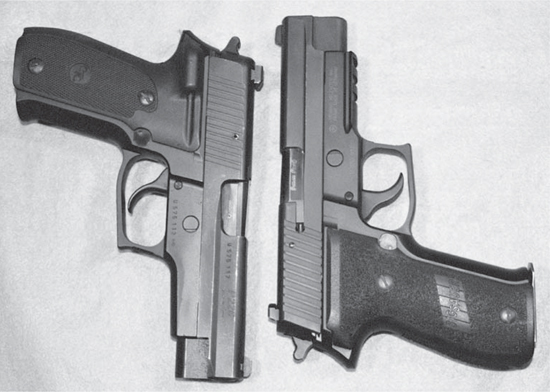
SIG-Sauer evolves the product as they find better ways to build guns. Left, an early P226 with separate breechface block, internal extractor, hollow pins. Right, current P226 with accessory rail, milled steel slide, solid pins, heavy-duty modern extractor.

Note that you can see daylight through the hollow slide pin of this older SIG. Current production uses stronger solid pins.
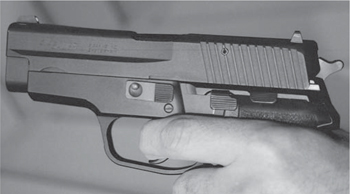
Its a stretch to call the SIG-Sauer southpaw-unfriendly, and this book explains the left-handed manual of arms for this pistol.
For many in law enforcement and the military, the long, heavy pull of a double-action trigger to fire the first shot is seen as a bulwark against accidental discharge. It is easy enough to shrug and say, Just keep your finger out of the trigger guard until youre going to shoot, but thats too pat an answer. Take a walk through a video store and look at how many of the video and DVD jackets portray someone holding a gunand notice how many depict the actor with his finger on the trigger. This sort of subliminal conditioning, along with a childhood of playing with toy guns, has left many people with a finger-on-the-trigger habit that takes a lot of time to train away. A firm resistance to an unintended pull is some degree of a safety net, and the SIG-Sauers have that.
I can think of three good-sized police departments who wont buy or authorize SIGSauers because these pistols do not have thumb safeties. Those three agencies require all personnel to carry their pistols on-safe. The SIG design parameter from the beginning was for these to be point-and-shoot pistols, simple to learn and simple to operate. It was felt that with a drop-safe gun, a manual safety was redundant, and not in keeping with the principle later heard at SIGARMS Academy, Simple Is Good. Although a few SIGs with magazine disconnector safeties were made up per government requests the SIG-Sauer has always been an automatic that you shoot like a revolver.
RELIABILITY
There will be comments from knowledgeable sources in this book about the final duel between SIG and Beretta for the U.S. military contract in the 1980s. It should not be taken as Beretta-bashing. After all, Beretta won. The final tests showed them neck and neck for reliability at virtually faultless levels. In 9mm service pistols, the comparison between the SIG P226 and the Beretta 92 is much like a comparison of the BMW and the Audi automobiles. In each case, both machines operate at the highest level of reliability and performance. Little things will dictate the choice. If you prefer to carry your pistol on-safe, you want a Beretta 92F. If you prefer to carry off-safe, you probably want a SIG P226, because it cant be found unexpectedly on-safe at the worst possible time. While Beretta offers the decock-only G-series, I dont find its operation nearly as ergonomic as the SIGs.
While I am one of those who likes the idea of an on-safe pistol, primarily from the handgun retention standpoint, the absence of that feature is not necessarily a deal-breaker. The selection of any firearm is going to be a balance of perceived needs with the features of the given gun. The SIG has a lot going for it, and should not be discarded from consideration because it does not have one particular feature.
WARTS AND ALL
This book will cover each of the SIG-Sauers, no holds barred. The good, the bad, and the ugly. No one has ever accused a SIG-Sauer of being a sleek or pretty gun. Its a tool, and a heavy-duty one at that. There is the occasional ammo incompatibility with this or that model, and these will be discussed with a view toward prevention and rectification.
SIG has been good about listening to constructive criticism and responding to it positively. One model would sometimes cycle too fast and fail to pick up the next round when loaded with +P+ ammo. That model is no longer imported. Another came with magazines that could jam during a slide-lock reload when wide-mouth hollow-points were used. Those magazines are no longer furnished with SIGARMS pistols.
One model was known to occasionally suffer frame cracks when fired extensively with hot loads. It was beefed up and the problem was solved. The hollow slide pins on the P226 used to start to work their way out in the course of long shooting sessions I remember pounding them back in place with a plastic Kubotan but SIG replaced them with solid pins in the mid-1990s and cured the problem. SIG grip screws had an irritating habit of loosening up in the course of intensive firearms trainingand damn it, they still do.

